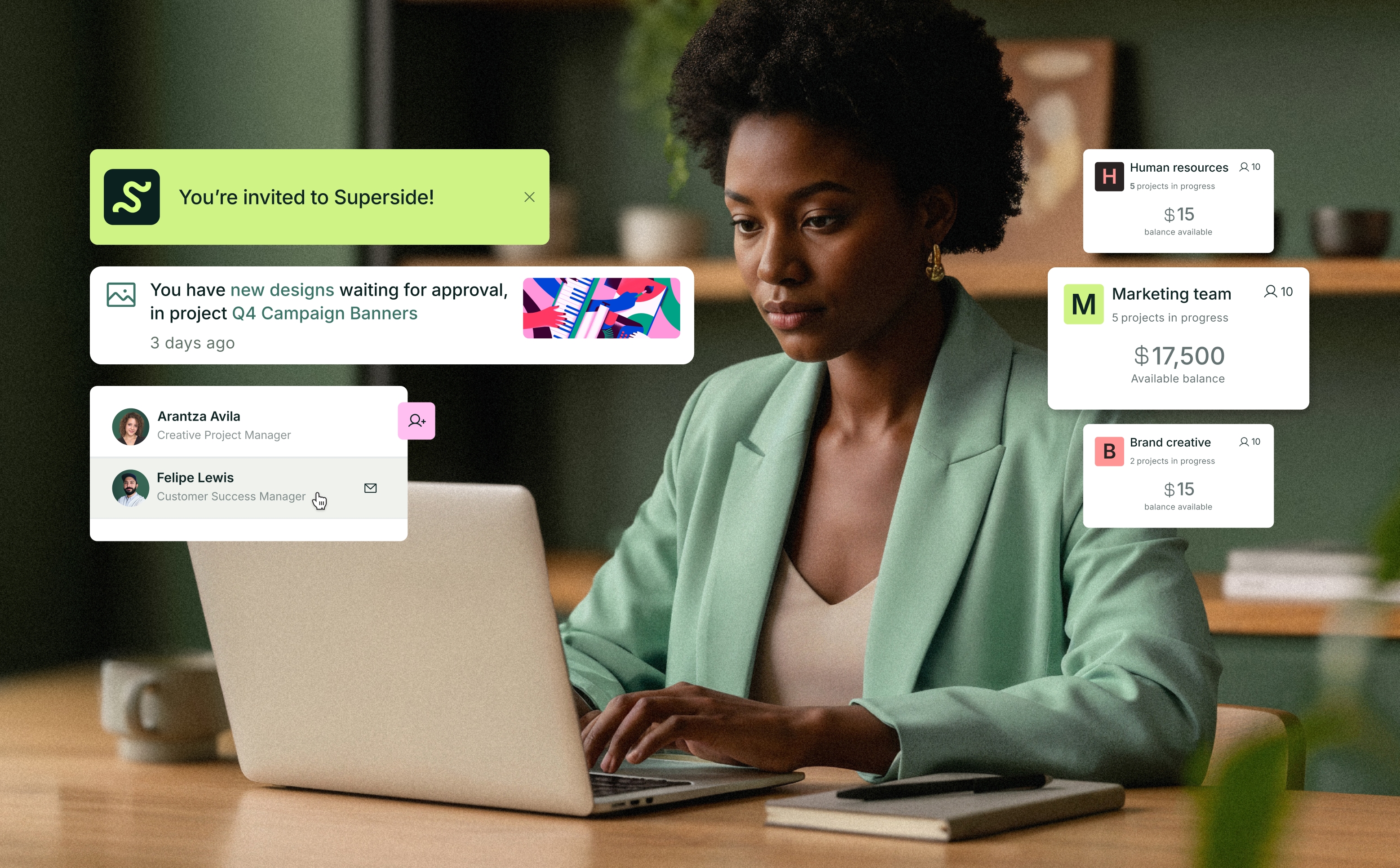
An effective content marketing strategy in these days is nearly unrecognizable from what it was even two years ago.
Audience targeting for paid social ads is less accurate due to changes in data privacy. Those same ads are also more expensive than they’ve ever been.
Meanwhile, brands are learning some key lessons from media companies about how to capture and measure attention from their core audiences:
- Repurposing blog content to include audio formats such as podcasts and listening options, like #paid does with its Banknotes publication
- Promoting in-depth research with short video previews on social media channels, like Superside does with its ebook releases
- Riding the meme marketing wave like Duolingo does with its TikTok account that boasts nearly 3M followers
“Cranking out content” is no longer a valid strategy. Here’s how you can build a flexible B2B content marketing strategy that makes sense for the Internet of 2022, where attention is more divided and channels are more saturated.
Table of Contents
What is “Content Marketing Strategy” in the modern era?
How to Rethink Your Content Marketing Strategy [Question Template]
Step-by-Step Guide to Creating a B2B Content Marketing Strategy
Content Marketing Strategy Checklist
What Does “Content Marketing Strategy” Look Like in These Days?
Content marketing is the strategic creation and distribution of online content for your brand’s audience to stimulate interest in your product offering. For B2B companies, it generates website traffic, leads, and sales for businesses doing business with other businesses.
A content marketing strategy determines your goals and tactics for producing valuable and shareable content across the “attention economy”—channels that serve your audience such as email, social media, search engines, etc.
Your goal is to serve valuable content throughout every relevant step of your buyer’s journey, or “funnel”. A traditional—or perhaps unrealistic—B2B content marketing funnel looks like this:
But content marketers now understand that most buyer’s journeys are anything but linear. The decision to buy within a complex attention economy may look more like this kind of roller coaster:
Nothing expresses this sentiment more than this tweet by Liam Taft, SEO Account Manager at The SEO Works:
What people think the marketing funnel looks like
— Liam Taft (@LiamTaftSEO) October 7, 2021
vs
What my actual buyer journey looks like pic.twitter.com/3s6IJzpB0m
If this seems like a lot, that’s because it is. But if you don’t have unlimited resources, you can’t be everywhere. That’s why a content marketing strategy with efficient content repurposing is so important — it will keep you nimble and testing what works while remaining focused on priority business goals.
How to Build a B2B Content Marketing Strategy [Question Template]
Where do you begin to define your content marketing strategy when it’s so hard to keep up with the pace of online discourse?
First, breathe. Second, remember to keep it simple—the best strategies are. Then, start with these anchor principles:
- Goals: Choose 2-3 focus goals for the quarter.
- Audience: Understand your ideal buyer’s pain points, goals, and trigger events.
- Channels: Determine channels to test based on audience presence.
- Voice: Define your ideal voice based on audience, then customize by channel.
- Differentiators: Understand your product’s unique value to inform content topics and angles.
Do some exercises in reverse engineering other content marketing examples to understand how they approach these principles. For example, Hypercontext gives us the following clues:
Goals
Hypercontext’s content mix can give us some clues about their goals.
Their State of One-on-ones Report, for example, isn’t gated, which means they’re likely more focused on organic search (keyword ranking, backlinks) than lead generation and list building (email signups, marketing qualified leads). Thought leadership and backlinks are likely a large part of their strategy.
Audience
Again, looking at the State of One-on-ones Report, Hypercontext calls out their audience category, pain points, and goals: managers across many industries and geographies who may not know how to approach one-on-ones and want to get better at it.
Their search rankings reveal more information about pain points, namely that their highest ranking content among high-volume keywords suggests that they’ve gone all-in on providing solutions to manager pain points such as lack of meeting agendas, employee departure, and making one-on-one meetings more efficient.
Channels
We can’t know every channel Hypercontext uses to distribute their content, but SimilarWeb can provide us with some information.
- More than 56% of their traffic comes from search engines—Ahrefs supports this analysis with a domain rating of 73
- More than 25% of their social network distribution comes from Yammer, which indicates that their content is shared in employee engagement communities
- A quick Reddit search shows that some content has received engagement on Reddit, such as this post in r/WFH named “PSA: Everyone should call into hybrid meetings to make them inclusive, not just remote workers.”
Voice
Hypercontext’s audience of managers are short on time, so they likely appreciate straightforward language that packs a punch with data. The report’s language avoids jargon, but it’s all business casual at the same time.
On Twitter, however, they allow themselves to be more casual with emojis and exclamation marks.
Is mercury in retrograde? Who knows!
— Hypercontext (YC S21) (@HypercontextApp) February 8, 2022
Regardless, these are the top management challenges (based on zodiac signs).
Ps. Full report dropping Thursday 👀 Comment with your horoscope sign and we'll send you an ungated link! pic.twitter.com/Ihs43Vzq78
Differentiators
The Hypercontext website tells us its main product benefit: making it easier for managers to run one-on-one meetings. Hypercontext is positioning itself as an expert on the ideal one-on-one meeting, and the report is a signal of that expertise.
You can see how Hypercontext ties their features and benefits to the content they create:
- Fuel 1:1 meetings → 4 One-on-ones you need to add to your calendar
- Run better meetings → 64 free agenda templates
- Add direction to your conversations → Founders: How to create a board meeting agenda that delivers value
Want more content marketing inspiration? Reverse engineer these examples to help kickstart your strategy.
Now that you know how to reverse engineer someone else’s B2B content marketing strategy, here’s a checklist of questions to ask for each section before you develop your own:
Goals
Audience
Trigger events are moments that inspire a person to buy something. Katelyn Bourgoin, CEO of Customer Camp, categorizes trigger events like this:
1/ TRIGGER EVENTS
— Katelyn Bourgoin ⚡️ (@KateBour) January 5, 2022
Every purchase begins with a trigger event. It’s the moment a buyer realizes they may need a new solution.
Trigger events can be:
Biological (eg. Being hungry)
Situational (eg. Getting engaged)
Emotional (eg. Feeling jealous)
Social (eg. Fight with spouse)
Channels
Voice
Differentiators
You should answer questions related to your goals, audience, and differentiators before you create your content marketing strategy.
Questions about channels and voice, however, may develop alongside your strategy as you find out what works and what doesn’t.
Your Step-by-Step Guide to Creating a B2B Content Marketing Strategy
Now that you know which questions to ask from the start, here’s how you can build your content marketing strategy, step by step:
Step 1: Perform a content audit
You shouldn’t develop new content until you know how your existing content is performing. Take stock of how you’re doing based on the following metrics:
SEO: Organic traffic, backlinks, internal links, keyword rankings, clickthrough rate and other SEO metrics
Website: Page views, session duration, and bounce rate
Social engagement: Likes, shares, and mentions
Sales: Leads, conversions, cost per acquisition, and return on ad spend for digital ads
Use the following tools to assess your performance across these areas:
Website: Google Analytics, Heap
Social engagement: SproutSocial, Hootsuite
Sales: Salesforce, HubSpot
Step 2: Assign themes to your content
Segment your top-performing content from each category. Do you notice any themes or similarities between them?
Develop categories for each piece of content and tag them by audience segment, theme, format, top-performing channel, and your own hypothesis about why it was so successful. You’ll need this information when you develop your content calendar later.
Step 3: Conduct keyword research and social listening
Keyword research is the backbone of most B2B content marketing strategies because it tells you what people are searching for. Use your content themes to guide your keyword research and identify secondary and primary keywords that should be incorporated into your content.
Keyword research is a large task in and of itself, so feel free to check out this helpful resource on keyword research by Ahrefs to get started.
We should note, however, that relying on keyword research alone isn’t enough to tell you what content your audience wants to consume. A content marketing strategy that keeps up with 2022 online discourse includes social listening from:
- TikTok
- Discord
- Slack
Your organic content strategy should be the direct result of data, industry insights, team expertise and intense social listening.
— Jen Hartmann (@jenalyson) July 7, 2020
Not because “Jerry in Marketing needs this posted by Friday”.
Find thought leaders in your space on those channels and follow people who engage with them frequently. That’s how you’ll really start to understand your audience’s content consumption habits and language.
Step 4: Plan your first content tests
Based on your content audit, keyword research, and social listening, you should have some solid hypotheses about which types of content will do well and where.
But you still have a lot to learn, so you’ll need to conduct some tests to see what works against your metrics. Here’s how to start planning:
- Match content formats to distribution channels to key performance indicators. This is your map to identifying content success or failure.
- Use ContentOps to determine the people, process, and tools to execute your tests.
- Outsource to a graphic design company like Superside when you feel ready to start scaling your split test efforts.
Here are some of the content marketing formats to consider for your B2B strategy:
- Blog articles on your website
- Original research studies rich in data and infographics
- Videos on YouTube, TikTok, Instagram, etc.
- Podcast advertising or podcasts
- Webinars and online conferences
- Ebooks and presentations
- Email newsletters
- Case studies
- Twitter threads
- Reddit AMAs
- Posts on LinkedIn, Facebook, etc.
- Interactive calculators, quizzes, and templates
A quick note about modern content calendars: The most effective content calendars are now the most flexible. Plan your content quarterly but leave room for the unexpected as online discourse changes in your category. Make sure your ongoing social listening efforts are responsive to what’s relevant for your audience.
Usually social media managers can plan out content 2+ weeks out in advance but in 2020 that has been an incredible challenge where 1 week can = 1-2 months.
— Charles Etoroma (@chvrlesjr) September 13, 2020
So can people please stop asking us what is your content plan for November.
Just trying to make it out of September.
Step 5: Produce your content
Once you’ve chosen your content channels and formats, it’s time to do the hard work of producing your content.
Every content format will come with its own set of resourcing requirements, but your workflow should look like this:
Research > Outline > Write > Edit > Design > More editing > Finalize
Step 6: Distribute your content
Every piece of content needs a distribution plan. This is so important it bears repeating:
Every. Piece. Of. Content. Needs. A. Distribution. Plan.
“Content is king, but distribution is queen. And she wears the pants.” -@JPerelman
— Kaleigh Moore (@kaleighf) July 27, 2021
Follow your audience’s lead on this. You should already know them fairly well at this point, and that means knowing where they like to consume your content.
Write down the most salient piece of information within your content and modify the language according to the rules of each distribution channel. Create your posts and send your content into the world.
Think of each distribution channel as a promotion lever for your piece of content. Ask the question: Which pieces of my content would work best for each channel?
For example, content from Superside’s Dysfunctional Design Process report was repurposed to distribute through Facebook ads, email, and LinkedIn posts. But what worked especially well for the report was breaking up the content into sections made for video, which extended the lifespan of the report and pushed people to consume the report as a whole.
In this case, embedded video created the following distribution circle:
Step 7: Measure your results
After a certain period of time, you’ll be able to attach performance metrics to each piece of content on each channel. Measure the results of your split tests and note any successes or failures so you can build on what works and reconsider what doesn’t.
Diagnose problems with specificity: If your email open rate was low, for instance, that indicates a weak subject line. If a YouTube video has a low view count, is it because it’s not ranking or because the thumbnail is producing a low clickthrough rate? Quick tip: Outsource your ad design to Superside or an agency to get the most out of testing.
Step 8: Repurpose successful content
This last step is going to take your content marketing strategy to new heights.
Your most successful content should expand to other formats and channels. For example, if you produced a report with original research that was downloaded so many times it blew your performance metrics out of the water, that’s an indicator to produce a video to accompany it. Or maybe a series of TikTok videos. Or a webinar. Or a whole podcast series.
Repurposing successful content has the following benefits:
- It makes content production more efficient
- It allows you to keep up with discourse on more channels
- It gives you more information about your audience’s content consumption habits
When you begin to repurpose content, you’ll start to loop your strategy: Releasing repurposed content on other channels will provide you with more data points about your audience, which then allows you to refine your goals.
While you won’t need to start from scratch every time, remaining agile while planning ahead will keep your strategy fresh and relevant with an audience you’ve invested in getting to know — which is ultimately the most effective strategy you can execute this year and beyond.
Book a call to talk about how Superside can help you produce on-brand social media graphics, animated explainer videos, blog headers, newsletter graphics, and more to unlock your content marketing strategy.












